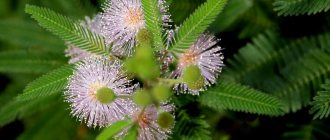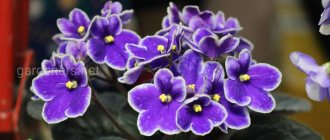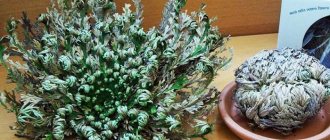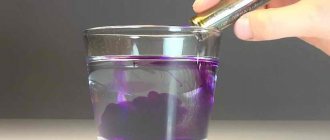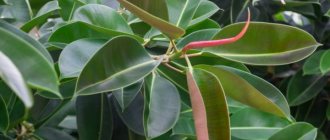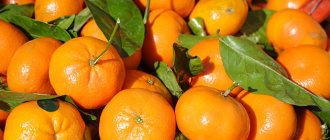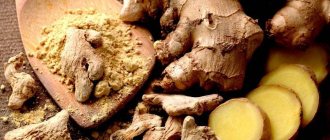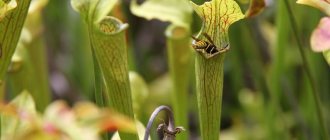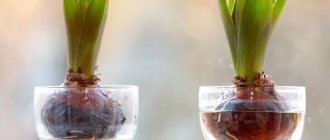Indoor araucaria is included in the list of evergreen coniferous plants that you can grow yourself at home. It is believed that it can purify the air. Caring for a small Christmas tree is easy if you know some features.
What indoor flowers look like a Christmas tree?
What indoor flowers are similar to conifers?
Apart from the commonly sold cypress trees, species from the genus Araucaria of the Araucariaceae family are very similar to the New Year's tree. In indoor floriculture, the most common plant is Araucaria heterophylla = Araucaria heterophylla , popularly Norfolk pine.
Needles of different types of araucaria:
The main requirements for keeping this plant: bright lighting, regular watering without drying out or waterlogging the soil, keeping it cool in winter (+10-+16 degrees) and high air humidity.
Another plant that looks like a Christmas tree can be called Cunninghamia lanceolata, popularly Chinese spruce , Cypress family.
Kuningamia, again, like most conifers, prefers cool, bright rooms with high air humidity, and does not tolerate heat and acidic soils.
Externally, the Christmas tree may resemble some types of coniferous indoor plants. One of the main “substitutes” for the Christmas tree is thuja. Thuja is a coniferous shrub and has many varieties. It is grown at home and in the garden, very often together with juniper, which also looks like spruce, but it does not grow at home. Caring for this “Christmas tree” is not so difficult; the “domesticated” thuja has soft, bright green spines, and it grows with its branches upward.
Selagenella can be considered something “Christmas tree-like”. True, it will not grow too tall; it is a small indoor plant, very soft to the touch.
Another option is indoor cypress. It grows low and soft to the touch. But there are varieties and selections of tall plants.
But Araucaria is a tall plant with hard leaves, about 0.5 meters in height.
Transfer
The tree does not really like replanting , so it does not require annual transplants. The plant should be replanted if it has “grown” out of its pot. That is, no more than once every 2-3 years. At the bottom of the container, good drainage is made from expanded clay and pebbles to prevent water stagnation. Soil for araucaria is made from a mixture:
- sheet (1 part);
- turf (2 parts);
- peat (1 part);
- sand (2 parts).
Another option - in equal shares:
- deciduous land;
- coniferous;
- turf soil;
- peat;
- sand;
- humus.
The houseplant Araucaria can also be grown hydroponically.
Indoor plants that look like a Christmas tree
The New Year holidays are over, the toys are put away, the Christmas tree is put away on the mezzanine until the next holidays. An artificial Christmas tree is certainly not bad, but how nice it would be to have a live tree in a pot at home and decorate it for the holiday for many years. Alas, the forest beauty does not like the microclimate of city apartments too much. So, is there really nothing that can be done about it? But it’s possible! There are indoor plants that look like a Christmas tree, but at the same time feel great in a city apartment or house. And I’ll tell you about some of them today.
How does Chamelacium reproduce?
To propagate Chamelacium, you need to cut off the top shoot and place it in a container with water.
Very simple. The apical shoot is cut off, placed in a jar of water or planted in a peat-sand mixture. After six weeks, roots should appear. After this, the plant is planted in the prepared soil.
Only the roots do not always appear. Experienced gardeners recommend setting aside more tops for planting when pruning plants. Then there is a greater chance that planting material will appear.
Araucaria
In my opinion, araucaria is the most similar to a real Christmas tree. This is an attractive and easy-to-grow coniferous plant with stiff branches covered with spiny leaves. Araucaria grows slowly; at home it can reach a height of 1.5 meters.
The plant prefers cool temperatures and needs good lighting. Does not tolerate drafts. To ensure that the tree grows symmetrically, it is best to grow it as a single plant. In winter, araucaria needs to be sprayed from time to time. Watering is regular from spring to autumn and moderate in winter.
Some growing difficulties
If you care for the Ophir variety or any other variety carelessly, then troubles are sure to arise. It should be said that by the appearance of this flower you can easily determine the cause of a particular problem.
- So, if there is a lack of moisture in the soil, the flowers of Chamelacium beki close. What should you do to make the chamelacium open? Increase watering immediately, otherwise the leaves will soon begin to fall off the flower.
- Leaf fall can also occur in low light conditions. However, this usually happens in winter if the plant is not additionally illuminated with a lamp.
- Fading leaves also indicate improper care of the flower. This can happen if there is a lack of nutrients in the soil or poor lighting.
As you can see, chamelacium requires attention. But how beautifully this Christmas tree blooms!
Olga Danilina
Cypress
Cypress, I would call the plant “two in one.” In winter, it will successfully replace the New Year tree, and in summer, in the yard or at the dacha, a pot of cypress can be placed near an inflatable pool and it will play the role of a southern cypress. This is one of the few coniferous plants that do well in an apartment.
Cypress prefers cool weather and does not tolerate bright light. It is better not to place it on windows facing the sunny side. Watering should be moderate but regular, but you can spray the plant at least every day. If you live in an apartment and don’t have a dacha, then at least you need to take the cypress tree out onto the balcony in the summer.
Where to put
— Lighting for araucaria should be bright, but protected from direct sunlight. When growing, the plant should be unrolled for uniform growth. For some species we use diffused light (tall araucaria), but the Chilean one can tolerate direct sun.
— The temperature for growing araucaria depends on the species. But you will have to observe the temperature regime, since this is one of the main conditions for successful development. Mature plants tolerate elevated temperatures well, but good ventilation in the room should be ensured. But young plants are very sensitive to cold temperatures.
— Humidity should be moderate. When indoor air is dry, we use daily spraying. Since very dry air can cause the shoots to dry out. You can also use humidifiers.
Planting in open ground
Conifers are found in areas in various compositions . They are even placed in containers on the roofs of houses, not to mention terraces, lawns, and hedges. The decorative form of young trees enlivens rock gardens and flower beds. But they look especially harmonious in company with other low-growing conifers. It is best to move decorative Christmas trees in February or March, and in the northern regions, when the ground thaws. To transplant from a container, it is advisable to choose a cloudy day.
To move a decorative Christmas tree, you need to prepare in advance: choose a place, decide on a time, dig holes, prepare a soil mixture for filling in the holes, stock up on mineral fertilizers, and water for irrigation.
The planting process itself should take place in the following sequence:
- Drainage is poured into the hole, then prepared soil. All this is watered abundantly.
- The plant is carefully removed from the container so as not to damage the root system and lowered into the hole.
- The trunk of the plant should be well aligned.
- Fill the voids with prepared soil mixture.
- Fill the filled hole with water (at least 10 liters per hole).
- Make a small hole next to the trunk for future watering.
- Cover the trunk with mulch in the form of broken bricks, gravel, pebbles, and covering materials.
Important! Since the roots of the tree are close to the surface of the earth, you should not compact the soil at a distance of one meter around the tree when planting.
How to plant a spruce tree
Spruce trees are very susceptible to movements from one substrate to another. They take a long time to take root. The most vulnerable part of the tree is the roots. They take root after transplantation for about 3 months. The right time for transplantation is spring. However, if the plant was purchased in winter and the pot is already too small for it, then manipulation can be carried out at this time of year.
Find out what to do if your Christmas tree starts to turn yellow.
The first step is to prepare the substrate. It is best to buy it immediately from the nursery where the spruce will be purchased. But if you want, you can do it yourself. The main thing to remember is that the plant needs soil that allows moisture to pass through well and is not too nutritious.
To prepare the substrate yourself you will need (mix in equal proportions):
- lowland peat;
- sand;
- vermiculite;
- perlite
About 20% of its total mass, wood ash, should also be added to the resulting composition. Regarding the container, it is better to choose a plastic option. It does not overheat too much in the summer and does not freeze very much in the winter, which ensures normal microflora in the root system. The size of the new pot should be 3 times larger in diameter and the same in height. The spruce should be planted in a container large enough to stimulate root development.
Important! After transplantation, the spruce trees shed some of their needles, and the ends of the branches begin to dry out. Don’t be scared - this is a normal adaptation process, you just need to create normal conditions and the tree will quickly recover.
Step-by-step landing instructions:
- First, in the evening, water the tree generously, but do not flood it (the ground should not turn into a swamp).
- Pour boiling water over a new container (to destroy bacteria), place expanded clay drainage on its bottom, about 5–10 cm.
- Place a layer of nutrient substrate (5 cm) on top of the drainage.
- Take the pot with the plant under the bottom with one hand, and grab the trunk with the other, as close to the root as possible. Having bent the container in one direction, gently, shaking the tree, begin to carefully pull.
- After removing the plant, evaluate the condition of the roots. If there are rotten or damaged ones, they should be cut off and the surfaces should be treated with wood ash.
- Place the tree in a new container. Make sure that the root collar is at the same level as in the previous pot. Fill the empty space with soil. If the transplant is carried out in winter, then the earthen lump on the roots should be left and moved together with it into a new pot, and if in the spring, it should be carefully washed off under running water and the substrate should be completely replaced.
- Water the tree with 1 liter of water.
What to do if the spruce crumbles and turns yellow
If not properly cared for, the crop begins to lose its needles. Such problems may occur in the following cases:
- the room temperature is too high;
- insufficient humidity and poor watering;
- the soil is too dense, the roots do not receive the required amount of oxygen;
- the appearance of pests.
To restore the seedling, you need to move the pot to a cool but well-lit place. If necessary, change the soil and water with warm water after the soil dries out a little. In summer, the pot of spruce should be placed on the balcony or open veranda.
NOTE! Konica is often damaged by thrips; for treatment, the tree should be treated with Aktara.
Redwoods
The tallest and oldest tree on the planet, the sequoia, grows wild only in California (USA). The branches of the conical crown are located strictly horizontally, only occasionally bending slightly downwards, the average life expectancy is about one and a half thousand years.
The tree is not grown in open ground at our latitudes; it needs a lot of moisture in the ground and air. Indoor bonsai-style options are more popular. They require a lot of patience and care, but the exquisite beauty of the composition makes up for all the difficulties.
Canadian spruce "Konica"
In most cases, you can find Canadian spruce of the dwarf variety “Konica” as a New Year’s decoration. Its tiny size, dense fluffy crown and short needles make this Christmas tree absolutely charming and desirable as an interior decoration.
To make it more attractive, it is often decorated with small toys and tinsel. This type of spruce belongs to zone 5 of frost resistance, that is, it can withstand frosts down to –30 degrees. It follows from this that with proper care, “Konica” is quite promising in the gardens of the middle zone, and it makes sense to try to preserve the tree before planting it in the garden.
Some gardeners have had Canadian spruce of this variety for about 10 years and is a dense pyramidal tree a meter high. The only drawback characteristic of Konica is the burning of needles in winter, but this problem can be easily solved by covering the crown with burlap.
Basically, this Christmas tree is an unpretentious plant, requires minimal care, tolerates partial shade and moderate watering. Canadian spruces Konika itself are sold as New Year's ones , but this spruce also has other varieties.
Varieties Rainbow's End and Daisy's White are not much different in appearance from "Konica", but in early spring the young growth of these Christmas trees has a very beautiful bright yellow growth. Blue Wonder spruce is distinguished by its unusual blue color with a characteristic conical shape and dense arrangement of branches.
Canadian spruce Rainbow's End. © Lyudmila Svetlitskaya
Caring for decorative spruce on the site
A coniferous plant after transplantation will not require much attention and time. There is no need to do additional replanting or pruning.
If the summer turns out to be moderately dry and hot , natural precipitation is enough for the tree. But during particularly hot seasons, watering will be required at least once a week. In this case, it is advisable to spray the crown with water.
The top layer of soil may form a dry crust. Careful loosening will be required.
During the first two years, measures should be taken to protect the conifer from possible severe frosts. To do this, in late autumn it is necessary to lay a mulch layer around the trunk.
In spring there is a threat of sunburn. This can be seen by the brown color of the needles. To prevent injury, experienced gardeners in early spring wrap the tree trunk with material that diffuses light and at the same time allows the plant to breathe.
Reproduction at home
Konica spruce can be propagated by both seeds and cuttings. To choose the appropriate method, you need to study the features.
Seeds
Seeds should be purchased in specialized stores. In order for planting material to sprout, it is recommended to follow this algorithm:
- soak the seeds in warm water for 1 hour;
- use a container with a depth of at least 20 cm, with a good drainage system;
- Fill the planting container with substrate for seedlings;
- the seeds are laid out on the surface and sprinkled with soil;
- The substrate should be poured with warm water on top.
The container with Konica seeds is covered with film and placed in a warm, well-lit place.
NOTE! After the first shoots appear, the film is removed.
Cuttings
Propagation by cuttings is used very often. To get a young copy, you need to perform the following algorithm:
- Carefully break off a young twig without any signs of damage or pests. You should break it off with your hands so that a small part of the wood remains, the so-called “heel”;
- place the cutting in Kornevin and cover with a bag. Leave for 2 days;
- prepare a nutrient substrate, which consists of humus and peat;
- plant the cuttings and cover with a bag, place in a warm place;
- water the cuttings every 3-4 days.
The duration of rooting is at least 6-7 months, when young shoots and roots begin to appear on the cuttings.
Type and varieties of chamelacium
The following varieties of chamelacium can be grown indoors:
| Variety | Description | Flowers |
| Hooked (wax myrtle) | In nature it reaches 2.5 m, in the house - up to 1.5 m. The leaves densely cover the trunk and grow up to 2.5-4 cm. | With a diameter of 1-2 cm, they form tassels or are arranged singly. Double and semi-double, yellow, white or red. |
| Snowflake | Reaches 40 cm in height. Used to create bouquets. | Pink and white, small. |
| Orchid | Low shrub with dense foliage. | Lilac and pink, the center is beetroot. |
| White (blondie) | Grows up to 50 cm, the foliage is elongated, bright green. | They are shaped like bells, white or light pink. |
| Matilda | Compact shrub plant with a dense crown. | Small, white with scarlet edging. Towards the end of flowering they acquire a purple or garnet color. |
| Ciliatum | Compact shrub used to create bonsai. | Large, light pink. |

